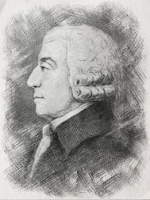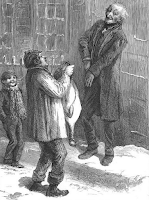As we saw in the previous posting on this subject, there was a movement in the early nineteenth century to broaden the base of capital ownership throughout society. This was justified based on individual human dignity (Cobbett), economic stability (Morrison), and as a counter to the spread of the “New Things” of modernism and socialism (the Catholic Church).
We haven’t really looked at socialism and modernism in this series, and probably won’t, but in one of the Papal States about this time Archbishop-bishop Pecci, later elected as Pope Leo XIII, was promoting widespread capital ownership. He started a savings bank in Perugia, capitalized in part with his personal funds, to help propertyless workers finance the acquisition of small farms or businesses.
From a strictly material point of view, a society characterized by an equitable distribution of productive power and adherence to Say’s Law of Markets has many advantages over both capitalism and socialism. The fact that it also fosters a fundamental respect for human dignity is a big plus.
 |
| Jean-Baptiste Say |
To explain, Say’s Law of Markets, while not really a law, and not original with Jean-Baptiste Say whose name it bears — although he expressed it best — is based on a fundamental truth on which all of economics is (or should be) based: you can’t consume what has not been produced. If something doesn’t exist, you obviously can’t do anything with it. That means that something must be produced before it can be consumed.
Unless we allow charity or theft to be the basis for economic activity — voluntary or involuntary transfers of what belongs to other people — there are only two ways in which anyone can have something to consume. One, he or she must produce it him- or herself. Two, he or she must produce something to trade for what someone else has produced.
 |
| Adam Smith |
In an economy in which everything works perfectly, what is produced will be consumed, and what is consumed will (obviously) have been produced. This comes from Adam Smith’s “first principle of economics as stated in The Wealth of Nations: “Consumption is the sole end and purpose of all production.”
The logic of Smith’s principle is obvious. Why produce something if you are not going to consume it? Producing for any other reason is (as far as Smith was concerned) contrary to common sense.
Smith’s logic and Say’s analysis give us the somewhat simplistic summary of Say’s Law, that comes across as a virtual tautology until we realize the principle and reasoning behind it. That is, “production equals income, therefore, supply generates its own demand, and demand its own supply.”
 |
| The Spirit is about to speak! |
This brings us to what we can call “the Fatal Omission” from virtually all proposals for reform and social betterment: money. Misunderstanding money and how to create and use it properly may be the single largest and most important factor holding back the reform of the institutions of the common good and thus the establishment and maintenance of an environment within which everyone has access to the opportunity and means to complete themselves and become more fully human — and without (necessarily) having to be visited by Scrooge’s three spirits.
In its essence, “money” is merely the mechanism, the social tool, by means of which I exchange what I produce for what you produce. This holds true even in the most basic or primitive exchanges.
 |
| "I need some lime in my cocoanut!" |
For example, if A has two fish, and B has ten cocoanuts, and they both agree freely that two fish have the same value as ten cocoanuts (and, of course, assuming B wants fish instead of cocoanuts and A wants cocoanuts instead of fish), they can come to an agreement. A will go away with ten cocoanuts he wants and without the two fish he doesn’t want, while B goes away with two fish he wants and without ten cocoanuts he doesn’t want. Both A and B are happy. “Money” has been created and cancelled.
We can take this simple example to the next level. Let’s assume fisherman A doesn’t have fish but still wants fish, while cocoanut gatherer B doesn’t have cocoanuts but still wants fish. If A and B trust each other, they can come to an agreement that if A will go fishing and give B two fish, B will go cocoanut gathering and give A ten cocoanuts. Both A and B “create money” by promising to deliver to each other fish and cocoanuts in the future. They then “cancel the money” when each one delivers what was promised to the other.
 |
| The prize turkey |
Obviously, there are a great many variations on these two basic scenarios, e.g., A has fish, but B doesn’t have cocoanuts or vice versa, C wants A’s fish and offers fifteen cocoanuts, nobody wants fish, and so on.
Now let’s take our example a step further. Man does not live by cocoanuts and fish alone, but by plum pudding and fat geese for the Cratchit Christmas dinner, and even prize turkeys sent over by Scrooge. People also want or need clothing, tools, other foods, drink, houses, and many other things on an endless list of items. That, however, creates a slight problem.
We know that two fish have the same value as ten cocoanuts, but how many cocoanuts have the same value as a suckling pig? How about a cooking pot? A knife? What if you have fish instead of cocoanuts, or a bag of rice?
 |
| Pay Neferatiti 2 cups of beer. |
Don’t try to figure it out, because in a pure barter economy, every marketable good and service must conceivably be valued in terms of all other marketable goods and services, and that gets unwieldy very quickly. It can be done, and even at a very sophisticated level. Ancient Egypt managed to develop an advanced civilization using a barter economy . . . and by having more scribes than you can imagine to record a huge number of transactions. The vast bulk of writings that survive from Ancient Egypt are accounting records.
There is a better and much easier way, however, and that is to develop a common unit of measure or standard of value in terms of which all other marketable goods and services in the economy can be measured. For example, draft animals are extraordinarily valuable in an economy that doesn’t have other, more technological power sources, so cattle were a common standard of value in many cultures and civilizations throughout history. The word “capital,” from “caput,” comes from head of cattle, while “pecuniary” comes from an archaic Latin word for “cow.”
 |
| Roman Æs Signatum, bronze sacred money |
Other cultures and civilizations have used lumps of metal. Bronze was considered “sacred metal” in Ancient Rome and continued as a standard of value long after the bulk of the currency was silver and gold. Still others have used human heads (Papua New Guinea), elephants, seashells, knives, shirts, loaves of bread, or anything else with a stable value and constant demand.
The point here is that a stable standard of value is of immense benefit to any society, and a virtual necessity if life is to advance and a culture develop. That is why Louis Kelso, the noted lawyer-economist who invented the Employee Stock Ownership Plan (ESOP), defined money in terms of its function as a unit of measure:
 |
| Louis O. Kelso |
Money is not a part of the visible sector of the economy. People do not consume money. Money is not a physical factor of production, but rather a yardstick for measuring economic input, economic outtake and the relative values of the real goods and services of the economic world. Money provides a method of measuring obligations, rights, powers and privileges. It provides a means whereby certain individuals can accumulate claims against others, or against the economy as a whole, or against many economies. It is a system of symbols that many economists substitute for the visible sector and its productive enterprises, goods and services, thereby losing sight of the fact that a monetary system is a part only of the invisible sector of the economy, and that its adequacy can only be measured by its effect upon the visible sector. (Louis O. Kelso and Patricia Hetter, Two-Factor Theory: The Economics of Reality. New York: Random House, 1967, 54-55.)
If, however, money is just a social tool that facilitates transactions between producers and consumers, why was there such a problem with it? Why didn’t it occur to anyone until Kelso that the financial system could be used to help people become capital owners rather than creating a barrier that keeps them in a state of semi or quasi slavery?
That is what we will look at in the next posting on this subject.
#30#
